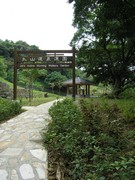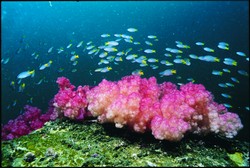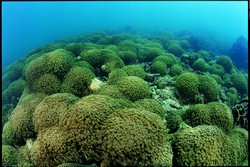
|
|||||||
| COUNTRY AND MARINE PARKS | |||||||
To conserve the countryside, some 41 644 hectares (about 38 % of Hong Kong’s total land area) have been designated as country parks and special areas. All 23 country parks and 17 special areas are managed for conservation, recreation, education and tourism. Hiking trails, nature trails, barbecue and picnic sites, camp sites and visitor centres are provided in the country parks, drawing some 12 263 000 visitors in 2006-07. Marine parks and marine reserves are also managed for conservation, recreation, education and scientific studies. There are currently four marine parks and one marine reserve, covering 2 430 hectares. They comprise scenic coastal areas, seascapes and important marine habitats with interesting marine fauna and flora, providing ideal opportunities for diving, snorkelling, canoeing and underwater photography. Some 203 800 visitors to marine parks were recorded in 2006-07. |
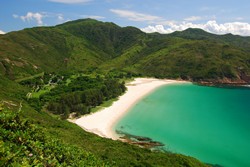 |
||||||
| HILL FIRES | |||||||
In 2006, 41 hill fires occurred over an area of 872 hectares with 75 400 trees damaged within or adjacent to country parks. The number of hill fires was slightly lower than that of the past two years. However, the damage caused by hill fires was greater than that of the previous year due to a severe hill fire in the Tai Lam Country Park in November 2006. Some 630 hectares of hillside and about 66 000 trees were damaged. To rehabilitate the areas damaged by hill fires, an aggressive tree planting exercise has been initiated. |
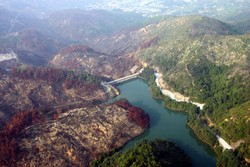 |
||||||
| TREE PLANTING | |||||||
Some 903 000 seedlings were planted in 2006-07, as compared with 855 000 in 2005-06. Native species such as Castanopsis fissa, Cinnamomum camphora, Gordonia axillaris, Liquidambar formosana, Machilus breviflora and Schima superba were planted, accounting for about 56% of all plantings. To enrich local plant diversity, the Department continued to produce seedlings of native tree species. Seedlings of uncommon species like Camellia crapnelliana, Camellia granthamiana, Camellia oleifera, Cryptocarya concinna and Cyclobalanopsis neglecta as well as seedlings of tree species that were not readily available in the market, such as Machilus chinensis and Machilus thunbergi, were produced for planting in country parks. |
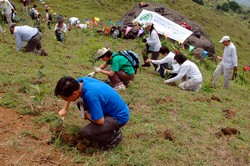 |
||||||
NEW FACILITIES |
|||||||
| Jat’s Incline Morning Walkers Garden | |||||||
|
|||||||
Ecological Enhancement Sites An eco-garden in the Tai Lam Country Park was completed in late 2006. It was originally a low-lying valley overgrown with grass of relatively low ecological value. To enrich its ecological value, various ecological enhancement works were carried out, such as planting different plant species to attract wildlife to the area. Interpretative signs were also installed to help the public gain a better understanding of and appreciate the ecological system, wildlife and plants therein. |
|||||||
| MANAGEMENT OF MARINE PARKS | |||||||
With the popularity of marine parks, a number of measures were taken to address the increase in visitors. These include increased patrols, with volunteers available to advise visitors, the provision of guided walks and the publication of educational materials. Law enforcement action was also taken to combat illegal activities. In April 2006, coral damage was recorded in Coral Beach of the Hoi Ha Wan Marine Park. Investigation indicated that the damage was caused by bio-erosion. Mitigation and rehabilitation works on the damaged coral were completed in November 2006. |
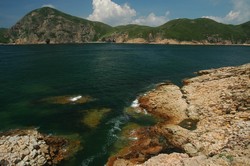 |
||||||
| NATURE CONSERVATION EDUCATION | |||||||
Publication of Nature Books To promote nature appreciation activities, we worked with the Friends of the Country Parks in publishing the “Nature Appreciation” series which included three books on the skills, activities and issues of conservation and nature appreciation. To meet the demand of readers and visitors, the 2006 “Eyes on Nature” series was launched, with information on country parks, their history, nature photography, hiking and camping and field guides. |
 |
||||||
Public Forums on Nature Appreciation Enhancement of Nature Appreciation Skills Workshops for Teachers and On-line Booking System To promote the countryside as a nature classroom and to support teachers in leading nature appreciation activities, the Department organised four workshops for over 700 teachers focusing on nature interpretation skills and utilisation of country parks as educational resources. The Department also launched a web-based booking system to support teachers in reserving guided educational tour services in various country parks. |
|||||||
Hiking Activities The Department co-hosted three public talks on the development of hiking activities in Hong Kong with the Hiking Association of Hong Kong, China and the Federation of Countryside Activities. Hiking group leaders, nature photographers and authors shared their insights on history and interesting stories as well as the development of organised hiking activities in Hong Kong. Over 500 participants took part in the three talks. To further promote hiking activities and hiking safety to the community, the Department regularly hosted public seminars on hiking safety with the Police, Civil Aid Service and the Scout Association of Hong Kong. In addition, comprehensive hiking information and safety hints are posted onto the website at www.hkwalkers.net for the public’s easy reference. |
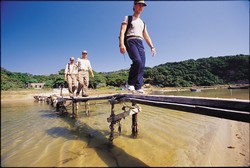 |
||||||
Marine Conservation Education Programme |
|||||||
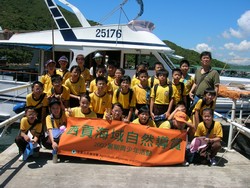 |
The Department organised a variety of marine conservation education activities targeting various sectors of the community. During the year, we organised 169 public eco-tours, 14 public seminars, 4 beach cleanup activities, 43 school lectures, 68 exhibitions and 33 other kinds of educational activities, benefiting over 147 000 participants. | ||||||
| LAW ENFORCEMENT | |||||||
Park wardens patrol country parks and special areas on a regular basis to provide visitor services and to enforce the Country Parks Ordinance and related legislations. In 2006-07, 1 128 offenders were prosecuted with fines totalling $1,222,980. Statistics are at Appendix 12. Under the Fixed Penalty (Public Cleanliness Offences) Ordinance (Cap. 570), 641 offenders were prosecuted for littering, spitting and dog fouling, 40 offenders were charged with unauthorised possession of protected plants or damaging plants, while 17 people were prosecuted for illegal use of fire in the countryside or a country park. Park wardens also conducted frequent special operations in the country parks, such as searching for illegal animal traps, visiting villages for the promotion of fire prevention and assisting the police in search-and-rescue exercises. Moreover, regular joint operations with the Police were arranged to combat crimes, such as robbery and illegal felling of Buddhist Pines and Incense Trees. In our marine parks and reserves, wardens patrol on a daily basis, paying special attention to possible illegal fishing activities and other offences. Close liaison is also maintained with the Marine Police as well as the Fisheries Authority of Shenzhen to combat illegal fishing by Mainland fishermen in marine parks. Wardens give advice or warnings to visitors and make prosecutions when necessary. In 2006-07, 149 prosecutions were made with fines totalling $159,100. |
|||||||
| MARINE CONSERVATION | |||||||
Reef Check The Department coordinates the annual Reef Check, in collaboration with the Reef Check Foundation. In 2006, 33 coral sites were surveyed with the assistance of over 330 volunteer divers. Twenty-one of the total 33 coral sites recorded high coral cover (i.e. more than 50%) and the growth of corals at all sites was stable. Results of the Reef Check were publicised to raise public awareness of the current status of our marine environment and to seek cooperation in protecting our precious marine resources. The findings also provided the Department with valuable information on coral conditions, enabling it to take appropriate action to protect local corals where necessary. Conservation of Corals Specially-designed marker buoys were installed at Sharp Island, Port Island and Ung Kong Wan for better protection of corals from anchoring damage. Regular sea patrols and underwater ecological surveys were also conducted to monitor the effectiveness of the coral marker buoys in those areas. The results to date are encouraging. There has been an overall increase in live coral cover in the marker area and damaged coral has shown signs of recovery. In collaboration with the Hong Kong Underwater Association and Ocean Park Hong Kong, the Department organised a photo and video competition in 2006 with a view to promoting the beauty and diversity of coastal and marine environment and enhancing the public’s understanding of the importance of marine conservation. The response was very good and over 500 entries were received. About one third of the entries were from students. |
|
||||||
Conservation of Marine Mammals There are about 1 200 to 1 300 Chinese white dolphins living in the Pearl River Estuary. About 200 dolphins of this population live in the western waters of Hong Kong around Lantau Island, Tuen Mun, Sha Chau and Lung Kwu Chau. The Department has been implementing a Conservation Programme for the Chinese white dolphin since 2000. Tasks include habitat protection and management, long-term monitoring of the population, investigation of dolphin stranding, promotion of public awareness of dolphin conservation, and liaison with the Guangdong authorities to exchange information on the conservation of the species. |
|||||||
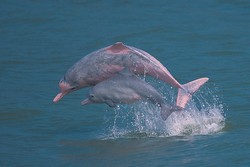 |
Dolphins are top predators in the marine ecosystem. To study the impacts of environmental contaminants on the health of dolphins, in 2005, the Department commissioned consultants to collect biopsy samples from Chinese white dolphins and conduct ecological risk assessment of environmental contaminants accumulated in dolphins. The study was on-going during the year. |
||||||
| Every reported dolphin stranding in Hong Kong is jointly investigated by the Department in collaboration with the Ocean Park. Tissue samples from stranding are collected for further studies. The Department also organises exhibitions and seminars as well as distributes posters and leaflets to promote conservation awareness, and publicise the code of conduct on dolphin watching and the dolphin stranding hotline. The public has gradually deepened their knowledge of marine mammals. | |||||||
| ENVIRONMENTAL IMPACT ASSESSMENT STUDIES | |||||||
The Department regularly provides comments and advice on development proposals and projects that might affect the marine environment. We also comment on EIA reports from a marine-ecology point of view. During the year, examples of projects studied included the proposed Port Development at Northwest Lantau, the Permanent Aviation Fuel Facility for Hong Kong International Airport, the Harbour Area Treatment Scheme, the Liquefied Natural Gas Receiving Terminal and Associated Facilities, a Logistics Park, the Hong Kong-Zhuhai-Macao Bridge and an Offshore Wind Farm. |
|||||||
